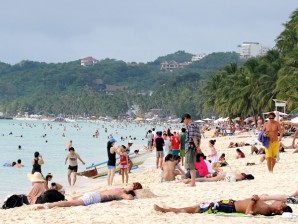Chinese, Taiwanese tourists return to Boracay
ILOILO CITY—Not even bad weather can stop foreign tourists, including those from China and Taiwan, from pouring into the world-renowned Boracay Island in Aklan province, with their number expected to surpass last year’s figure by 300,000.
The Department of Tourism regional office estimated tourist arrivals at 1.5 million by yearend, exceeding the 1.2 million recorded the previous year. From January to September alone, the number reached 1,073,645, or 15.12 percent higher than the 932,648 over the same period last year, it added.
Koreans still comprised the biggest number of foreign tourists, followed by Taiwanese and Chinese tourists.
Earlier this year, resorts and hotels in Boracay suffered losses from cancellations of tours and bookings by visitors from China and Taiwan amid a diplomatic row between Taiwan and the Philippines stemming from the killing of a 65-year-old Taiwanese fisherman by Philippine Coast Guard personnel off Balintang Island in northern Philippines on May 9.
China also imposed a ban on travel groups to the Philippines as claims over the Panatag Shoal (Scarborough Shoal) between the two countries seethed.
Article continues after this advertisementTourism Regional Director Helen Catalbas said the number of tourists from Taiwan and China had already gone up. She attributed the spike in tourist arrivals to the heightened promotion campaigns, improved accessibility to Boracay, and the return of the Chinese and Taiwanese.
Article continues after this advertisementThe number of domestic tourists has also continued to increase, reaching 569,641 or 53 percent of tourist arrivals.
More international cruise ships have visited Boracay, Catalbas said. Three of them have made daylong stopovers, she said, while two more with 2,000 passengers each would visit the island this week and next month.
The upswing in tourist arrivals also boosted revenues to P19.737 billion from January to September, surpassing the P17.145 billion registered during the same period last year. Nestor P. Burgos Jr., Inquirer Visayas
